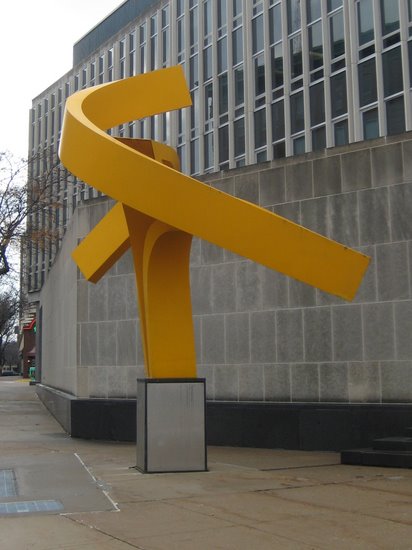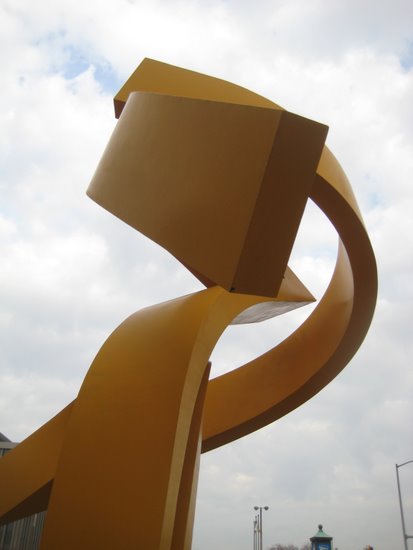A 22-foot-high, brightly painted yellow-orange aluminum sculpture was installed at 100 17th Street in Rock Island in 1982. Placed near the entrance of the First National Bank of the Quad Cities, it was created to invite the viewer to join the celebration of the bank's 130th anniversary. The sculpture was titled, appropriately, Invitation.
Though the building is now the Modern Woodmen Bank building, Invitation stands in the same location. Its intense and pure color suggests a brightly colored flower, and the sculpture seems to bloom from its relatively small, rectangular base - almost like a rapidly growing plant in a vase that has become too small.
The uniform color, on the other hand, suggests industrial fluorescent yellow. Though the sculpture's shapes are fluid, even elegant, they are formed from hard-edged, seamless sheets of metal. The sculpture's dynamic arcs seem to describe enormous paths of flight - more akin to a jet fighter than a bird.
The artist, Gene Horvath, explained about his work in 1982: "One concept of the universe is that it is expanding rapidly, but is curved, folding back upon itself. As a sculpture, Invitation attempts to capture some of this spatial majesty by folding back upon itself. The two interrelated sculptural groups also suggest some of the tremendous energy of the universe through their rapid change in direction and the arrow-like configuration at their juncture points."
Perhaps a more aesthetic location - removed from concrete, buildings, parking lots, train tracks, traffic lights, and passing vehicles - would allow the work to more fully communicate this greater meaning. Yet moving it to an art museum would only result in taking it out of our daily lives.
Born in Columbus, Ohio, in 1927, Horvath was an art director in Chicago, Nebraska, and Rockford, Illinois, for 35 years before turning to a second career as a sculptor. Based in Rockford, Horvath pioneered and patented a fabrication process that allowed him to create massive metal works. From 1972 until his death in 1995, he completed more than 30 large-scale commissions located primarily in Illinois (Rockford, Springfield, and in the Chicago area) but as far away as Arizona.
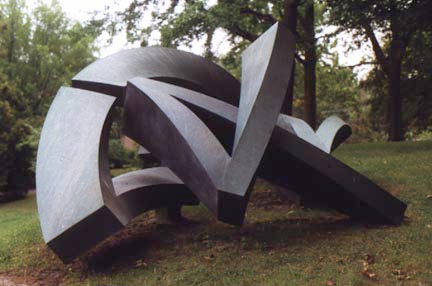
In addition to Invitation, several other works by Horvath are located in the Quad Cities. Meeting Place is situated on a grassy slope just south of the college center on the Augustana College campus. While Invitation thrusts upward, Meeting Place massively spreads outward over an area of ground 24 by seven feet. Still, it doesn't overwhelm its natural setting.
Its seamlessness makes the work seem almost effortless. One really doesn't feel the artist's struggle with its composition or materials, yet three years of developmental work were involved in solving the complicated problem of twisting large metal forms before its installation in 1981.
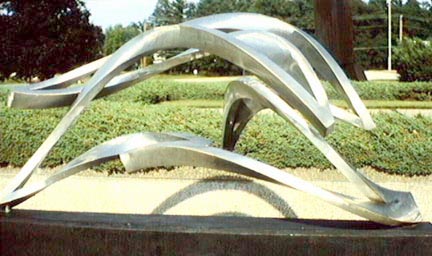
Placed at the entrance to the Davenport Art Museum in 1983, Rhythm greeted visitors to the gallery for two decades before it was closed and the sculpture removed. Until a new location is chosen, it is in storage in the Figge Art Museum. Rhythm has much of the same sense of openness as Invitation, though it is smaller in scale - less than seven feet long. The sculpture has the undulating motion of waves of water, made all the more fluid because of its stainless-steel surface.
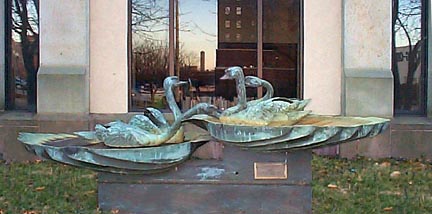
A fourth sculpture, Essere Umano, is located on the north side of the Rock Island Public Library at Fourth Avenue and 19th Street. The enigmatic title means "to be human" in Italian. Unlike his other sculptures in the Quad Cities, Essere Umano is representational. The four swans are approximately life-sized and naturalistically proportioned.
At first glance, it seems to have been made by a different artist. Yet the interplay between and gestures of the swans are reminiscent of the relationships between forms in his other works; each shape - whether made of steel or described by the open spaces - responds to or even communicates with the others. The titles - Invitation, Meeting Place, and Rhythm - also suggest that relationships are the primary meaning of his works.
Bruce Walters is a professor of art at Western Illinois University.
This is part of an occasional series on the history of public art in the Quad Cities. If there's a piece of public art that you'd like to learn more about, e-mail the location and a brief description to BD-Walters@wiu.edu.

